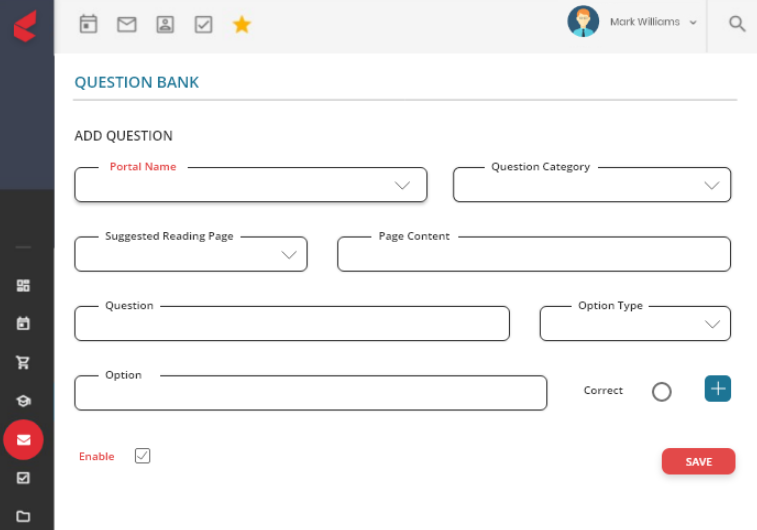You’ve got the Learning Management System (LMS) up and running, and now you’ve got these questions.
Are my employees benefiting from the LMS?
Are they comprehending the learning?
How long does it take them to complete a course?
Is the learning material adequate?
That’s a lot to think about.
Leave your concerns behind and discover what to track in your LMS. Use LMS tracking and reporting to determine whether your training efforts are successful or not as it walks you through statistics that provide a 360 ° view of the training impact.
Learning management system tracking allows you to
- measure the progress of trainees
- understand training outcomes
- review learning materials
- create reports to submit before the board management.
Ideally, it provides you with an overview of the employee training requirements.
“Nearly 70% of learning and development (L&D) teams state that they feel pressure to measure the impact of learning from leadership.”– (Learning Technologies, 2019).
Here are the 10 best ways to track training data in your LMS
1. Track Learner Progress
When employees must complete particular hours of training or meet certain training requirements, an LMS can be a useful platform to track the progress of all employees. Here are some actions that managers can do.
- Track the number of completed courses and overdue ones to understand learner progress.
- Take urgent action on low engagement levels of trainees by applying multiple filters to generate statistics on a particular department, region, or job role.
- Rely on the information generated from LMS to encourage staff not to slip behind and to complete their training on time.
Image: source
2. Track Results
The training results of specific learners give an accurate representation of their performance. Therefore, identify high-caliber employees or those who require further attention by keeping track of,
- Course statuses and the number of attempts
- Time spent on each course
Also, should your average score for all trainees go high, consider revising your training content to make it more challenging, or vice versa.
3. Track Specific Course Details
- Gauge the efficiency of a course– Tracking individual course details can be helpful in measuring the efficiency of a course, particularly when it’s very advanced.
- Know how the learner is getting along– The completion status, scores, and time spent on each module for a specific course provide a wealth of information regarding individual learner development. Further, determine why learners repeatedly fail a particular section or module of a course.
- Notice the flaws in the content– It enables you to quickly discover what is amiss with the material such as inadequacies or intricacies of the training material if any. In such cases, it’s best to rework the content.
4. Track Progress in Quizzes
The results of quizzes help you identify the employees who have completed their certification. This information is quite useful during the appraisal process to encourage those who are falling behind in the training.
5. Track the response breakdown for tests
Why should you do this?
- Many times, you must have noticed that a large proportion of trainees are unable to proceed past a series of questions.
- In this scenario, ensure that the objective of the question is clear and free of ambiguity and that the answer to the question is truly contained in the course.
- To address this, add extra explanatory information to the existing content or include video links for better comprehension of the specific topic.
Fairly, you have just gained more than a handful of action items to work on!
Image: Kapture LMS Question Bank
6. Track the top scorers
Pick the best resources and easily fill leadership roles!
Data on top scorers in a particular course can be used to identify the best of the bunch.
Spot talented resources for a given skill set. Utilize this data to pick employees for leadership assignments, new roles or to determine promotions.
7. Track session details
- Learn how many people signed up for the course, how many dropped out, and how many showed up.
And now, what to make of the attendance rates?
- The course turnout percentage gives you a glimpse of the courses that are valued by employees.
- Significant attendance rates are strongly tied to employee self-development, something that’s incredibly beneficial to the organization.
- This obviously implies the level of staff participation and enthusiasm.
So, indulge in one-on-one conversations to determine what keeps them off the training.
8. Track feedback
- Conducting surveys or interviews will assist you in determining what is working well and what courses need to be modified or polished to suit the needs of your trainees.
- Make changes that benefit the bulk of your learners, not just a small group.
- Incorporate the feedback to make learning smart and less complicated.
“75% of employees prefer video-based learning over reading information”- (Designing Digitally, 2019).
Image: Essential LMS and eLearning statistics
- Building and modifying your LMS in this manner will result in a learning platform that is well acknowledged by trainees and departments across the organization.
9. Track time log
- Know the challenging sections of the course– The time logs show how long it takes for learners to finish an online training course or exercise from which you can determine which sections of the online training course are difficult.
- Assess the motivation level of learners– When learners slack off, it suggests that they aren’t motivated enough or don’t have the essential skills or information to get past the course smoothly.
As a result, you may need to integrate more real-world online training activities to assist them in gaining experience and expertise.
The trainees will be able to develop a stronger bond with the subject matter this way.
10. Track follow-up assessments
If they don’t recall what they’ve learned, they’re unlikely to apply the learnings at work!
Configure your LMS to conduct tests or follow-up assessments at regular points following a course in order to track learners’ understanding.
Benefits of Learning management system tracking
Helps you stay updated at all times
Reporting is no longer a mindless task to be undertaken once a month. To keep ahead of the game, you must compile reports whenever there is a need to address a training-related issue.
For example, when a new course is released, you can get an immediate reaction to see how well it is accepted by your staff.
Spot problems early
Fix problems right away by generating reports in an instant. Do not wait till you get to a certain point to generate reports on specific areas.
Compare training data
When you provide multiple pieces of training to different departments, you can compare the reports and determine which department needs further refinement of the training.
Customize the report to suit your needs
- The last thing you want to do when reporting on your organization is to use pre-defined reporting fields. In such cases, you see the reports that you are shown rather than the reports you would like to look at.
- When you create reports that draw data straight from your Learning Management System, you would be able to see customized reports.
- You can also divide your reports into several smaller reports, allowing you to focus on one topic in your attempt to draw sensible conclusions.
Why Kapture LMS?
While organizations measure business success, profitability, and growth, there is also a compelling need to evaluate the effectiveness of the training programs.
A Learning Management System (LMS) with built-in reporting and analytics can help you do this quickly and easily and is a ‘must-have’ for providing an exceptional learning experience to trainees.

With Kapture’s LMS tracking,
- Assess the effectiveness of training.
- Generate real-time reports.
- Access training modules in any format (PowerPoint presentations, videos, texts, and more). In both online and offline modes!
- Navigate smoothly through course materials.
- Export reports in the format you prefer.
- Schedule automatic reporting.
- Customize assessments.
Corporate training is not done for the sake of training, but to meet business goals by providing employees with the necessary certifications and expertise.
It’s not going anywhere unless proper training, tracking, reporting, and continuous quality improvement are implemented.
Go for a free demo of Kapture to explore LMS tracking features in real-time!
About the Author | |
 | Seema C Mohan |
| Seema C Mohan is passionate about all things XaaS and loves to write value-added content. She has been in Business Process Management in the past and has published technology articles in journals. | |
,
,
,
,
,
,
,
,
,
,
,
,
,










